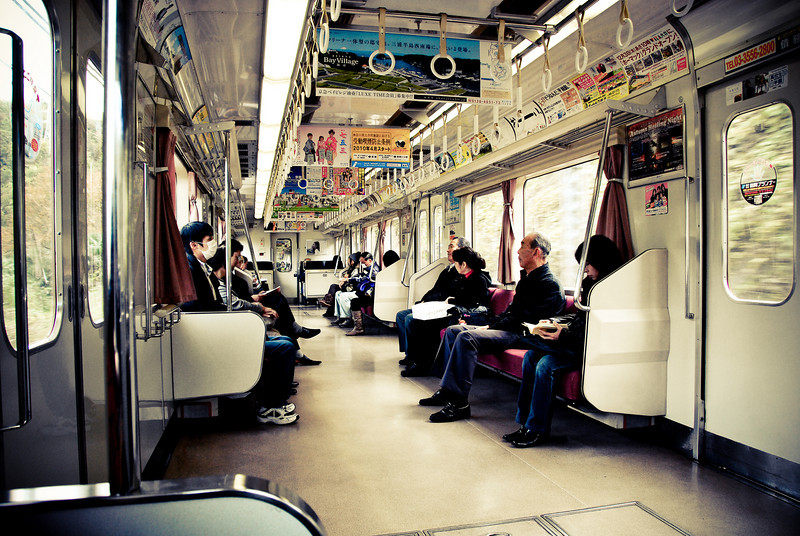JAPAN RAIL (JR) PASS
Any foreigner traveling to Japan should buy a Japan Rail (JR) Pass. The passes are discounted unlimited use of Japan Railway Lines in Japan. In general, you can travel the whole of Japan using your JR pass. You will however still need to pay for the independent rail lines that are not operated by JR (smaller routes, side routes etc…).
WORTH IT?
If you are planning to at least take one or two long distance train, the passes are worth it. For example, the price of a roundtrip Shinkansen travel between Tokyo and Kyoto is approximately 26,400yen (13,200yen one way with reserved seating). A 7-day JR pass costs 28,300yen. Add in the costs of local JR train travels, the JR Pass is well worth it. It won’t be worth it if you’re only planning to travel around within Tokyo and not do any long-distance traveling.
Check Hyperdia to see how much your trips may cost and if it is worth it to buy the JR pass.
HOW TO OBTAIN PASSES?
These passes can only be purchased outside of Japan. See here for locations in your area to purchase the pass. The passes are 7-day, 14-day or 21-day passes. Prices are here.
When you purchase the pass, you will get an “exchange order”. It is valid for 3 months from the date of purchase. Once you get to Japan, you will need to exchange the “exchange order” for your actual JR Pass by showing the exchange order and your passport. The pass is valid for either 7, 14 or 21 days (depending on which pass you purchase) starting the first day you use the pass. You can specify which day you want to start using the pass when you obtain your passes.
There are many places to exchange your pass. The most convenient location will likely be the one in Narita Airport. When you get out of immigration at the airport, look for escalators going down a floor to the railways. There will be a JR Pass exchange center on that floor. You can also just ask anyone around for “JR Pass” and they’ll point you in the right direction.
WHICH TO GET?
There are two types of JR Pass: Green and Ordinary.
- Ordinary passes are the cheaper of the two. This is the pass that J & I purchased for our trip to Japan this time. With an ordinary pass, you will board the regular cars on local trains where there are seating on the sides and standing space. On long distance shinkansen, you’ll get the regular cushioned seating like airplane seating.
- Green passes are more expensive because it gives you access to upgraded or first-class seating in the local trains (airplane like seating as opposed to standing space with seating on the sides).
In our opinion, the ordinary passes are sufficient. The seats in the shinkansen are more comfortable then seats in a plane in our opinion. You can always upgrade to a green car by purchasing the ticket (top up the difference) per train ride that you want to get on.
To start with, have them get you a reserved ticket for seating on the Narita Express to Tokyo. Normally it’d cost about 3000yen one way. It is now free with your JR Pass.
We were in Japan near New Year’s so there were days when the trains were packed full of people trying to get home for the New Year’s. We had to stand in a crowd of people near the lavatories on one of our shinkansen rides because there were no regular seats left – this was the one time we wished we had the Green Passes where there were seating (upgrading it at that time actually would’ve cost too much for us, so we didn’t upgrade). Other times, when there shouldn’t be a hoard of people taking the trains, you should be OK with just the ordinary passes.
One thing we found very useful was to tell the officers at the JR pass exchange centers our itinerary and had them reserve seats for us on certain trains (e.g. Shinkansen) and give us the tickets at that time. Otherwise, you have to go to a station and get those tickets yourselves (these are free of course because you have your JR pass). To start with, have them get you a reserved ticket for seating on the Narita Express to Tokyo. Normally it’d cost about 3000yen one way. It is now free with your JR Pass.
HOW TO USE THE PASS?
How to use your Japan Rail Pass from JRPass.com on Vimeo.
See above for a video of how to use your JR Pass. Once you obtain the passes, just go through the gates at JR stations that are manned by the railway officers by showing them your pass to get through the gates.
SUICA CARD
Another useful card to get when you arrive in Japan is the Suica card. It is essentially a convenient, prepaid, rechargeable card for travel on subways, busses and railways that we use for travel that are not covered by our JR pass.
It costs 2000yen (~$25). It includes 500yen deposit (returned to you when you return the card) and 1500yen initial credits in the card. You can always top up the credits at any kiosks located in stations around Tokyo. We obtained this at the train station the first day we arrived. It saves you time standing at the railway stations looking up the stations you want to go to and purchasing tickets to get through the gates etc… not to mention the need to carry cash/change to pay for each ticket.
WHICH TRAINS TO TAKE?
Here’s a great website that you should use for planning your trips around Japan: http://www.hyperdia.com/en/ Just type in the closest railway station you’re at and the destination and it’ll provide you with an easy to understand railway & subway routes you should take.
USEFUL PHRASES
There are some useful japanese words we used often that helped us get around that you can use too when you’re in Japan:
- [location], do-chi-ra desu-ka? This means… where is the direction to [location]. By asking this, people will usually point you in the direction to walk or tell you the train track number to use.
- Ma-su-gu. This means go straight.
- Hi-da-ri. This means left.
- Mi-gi. This means right.
- Ko-ko. This means here.
- A-ri-ga-tou-go-zai-masu. This means thank you.
- Su-mi-ma-sen.This means “excuse me” or “pardon” or “sorry” in some cases.
Have fun getting around!
7 Comments
-
Hi! im planning to go to tokyo with my bf during new years too. We are planning to stay in only tokyo so does that mean we wouldnt need a JR pass? I am a bit confused on the train system in japan. Would i only need a Suica card if staying primarily around Tokyo?
-
Author
Yeah, I’d say if you’re just staying in Tokyo, then you do not need the JR Pass. A Suica card should be good.
Check http://www.Hyperdia.com to see how much your local trips may cost.Hope this helps!
Jeremy & Shirlene recently posted..{Hungary} Buda Castle, Parliament and Fisherman’s Bastion – Stunning Sights in Budapest
-
-
Hi Jeremy & Shirlene,
I aready sent a email to editor@idelish.com. Hope you have received my email. Thanks for your help
-
Do you have week 2 & 3 week of of your japan itinerary. Also how many days JR Pass you bought and went did you activate it?
-
Author
Hi Ryan – please email us at editor@idelish.com. I can share our itinerary with you through email. We purchased the 14-day pass and were in Japan for 3 weeks. We activated it the day we needed to travel from Tokyo to elsewhere on the shinkansen. We planned it so that the 14-day pass covered the travel on the shinkansen we needed to do and the remaining week (start and end of our trip) was spent in tokyo.
Jeremy & Shirlene recently posted..{Worldwide} Our 7 Links, What You May Have Missed the Past 7 Months
-
-
Is Japan’s JR Pass worth it for you? –> {Japan} Getting Around in Tokyo http://t.co/UvyFLiAk #Japan #tokyo #trains #travel







